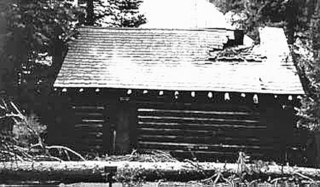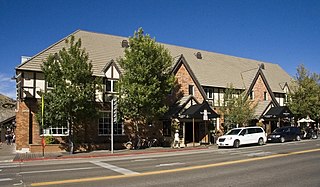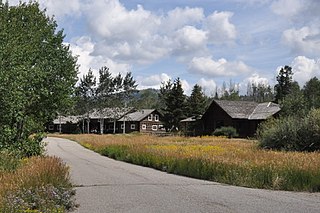
Lander is a city in Wyoming, United States, and the county seat of Fremont County. It is in central Wyoming, along the Middle Fork of the Popo Agie River, just south of the Wind River Indian Reservation. It is a tourism center with several nearby guest ranches. Its population was 7,546 at the 2020 census.

The 4 Lazy F Ranch, also known as the Sun Star Ranch, is a dude ranch and summer residence in Jackson Hole, Wyoming, built by the William Frew family of Pittsburgh in 1927. The existing property was built as a family retreat, not as a cattle ranch, in a rustic style of construction using logs and board-and-batten techniques. The historic district includes seven cabins, a lodge, barn corral and smaller buildings on the west bank of the Snake River north of Moose, Wyoming. The property was added to the National Register of Historic Places in 1990.

The Death Canyon Barn is a combination barn and ranger patrol cabin in Grand Teton National Park. The barn was built in Death Canyon on the Death Canyon Trail at its junction with the Alaska Basin Trail by the Civilian Conservation Corps in 1935 in the National Park Service rustic style. Located with a clear view of Prospector Mountain, it shares a common style and purpose with the Cascade Canyon Barn to the north in the park, with minor differences attributable to available materials and the preferences of the work crews building the barns.

The Bar B C Dude Ranch was established near Moose, Wyoming in 1912 as a dude ranch by Struthers Burt and Dr. Horace Carncross, using their initials as the brand. Rather than converting a working ranch, Burt and Carncross built a tourist-oriented dude ranch from the ground up, using a style called "Dude Ranch Vernacular", which featured log construction and rustic detailing. As one of the first dude ranches in Jackson Hole, the Bar B C was a strong influence on other dude ranches in the area, and employed a number of people who went on to establish their own operations. It was acquired by the National Park Service and incorporated into Grand Teton National Park upon the expiration of a life estate. The ranch was listed on the National Register of Historic Places in 1990.

The Double Diamond Dude Ranch Dining Hall was built in 1945 as the centerpiece of a dude ranch operated by Frank Williams and Joseph S. Clark, Jr. in Grand Teton National Park. The ranch was opened in 1924 with a dozen tent cabins and log buildings for a kitchen and dining hall, lounge and commissary. In 1943 Williams built log tourist cabins, followed by the larger dining hall in 1945. The 1985 Taggart Lake Fire destroyed much of the ranch, sparing only the dining hall and five cabins. The dining hall is listed on the National Register of Historic Places as an example of rustic architecture. Since 1970 the Double Diamond property has been a hostel for mountain climbers in the Teton Range, and is known as the Climbers' Ranch.

The Wort Hotel was built in downtown Jackson, Wyoming, United States by brothers John and Jess Wort, who were significant figures in the transformation of the economy of Jackson Hole from ranching to tourism. The somewhat Tudor-style building was the first luxury hotel in Jackson. The two-story building features brick facing, with half-timbering and stucco on the second floor and a series of gables facing the street.

The Ramshorn Dude Ranch Lodge in Grand Teton National Park was built after 1935 by mountaineers Paul Petzoldt, founder of the National Outdoor Leadership School, and Gustav Koven. The property that became the Ramshorn Ranch was originally established by Ransom Adams at the mouth of Gros Ventre Canyon near Ditch Creek. By 1921 the property was acquired by Jack and Dollye Woodsman, who established the Flying V dude ranch, featuring a large central lodge. In 1932 the lodge burned, prompting the Woodsmans to sell the ranch to Koven and Petzoldt in 1935, who planned to expand the dude ranch as a climbing school and hunting camp. Petzoldt withdrew from the partnership in 1937 after suggesting the name be changed to the Ramshorn Ranch. The present lodge was completed in 1937 by the Woodward brothers, who took over operation. A variety of owners and partners ensued until 1956, when the ranch was sold to the National Park Service. The Park Service then leased the ranch back to concessioners who operated it as the Elbo Ranch until 1973, replacing the former Elbo Ranch purchased by the Park Service. The Teton Science School was established on the property in 1974 under a special use permit.

The White Grass Dude Ranch is located in the White Grass Valley of Grand Teton National Park. The rustic log lodge, dining hall service building and ten cabins were built when a working ranch was converted to a dude ranch, and represented one of the first dude ranch operations in Jackson Hole. The White Grass was established in 1913 by Harold Hammond and George Tucker Bispham, who combined two adjacent ranches or 160 acres (65 ha) each, and was converted to a dude ranch in 1919. Bispham had worked at the Bar B C before moving out on his own. The dude ranch operation continued to 1985, when the ranch was acquired by the National Park Service.

The Jenny Lake Ranger Station Historic District comprises an area that was the main point of visitor contact in Grand Teton National Park from the 1930s to 1960. Located near Jenny Lake, the buildings are a mixture of purpose-built structures and existing buildings that were adapted for use by the National Park Service. The ranger station was built as a cabin by Lee Mangus north of Moose, Wyoming about 1925 and was moved and rebuilt around 1930 for Park Service use. A store was built by a concessioner, and comfort stations were built to Park Service standard plans. All buildings were planned to the prevailing National Park Service Rustic style, although the ranger station and the photo shop were built from parts of buildings located elsewhere in the park.
The UXU Ranch is a historic dude ranch in Shoshone National Forest near Wapiti, Wyoming. The ranch began as a sawmill, as early as 1898. In 1929 Bronson Case "Bob" Rumsey obtained a permit from the U.S. Forest Service to operate a dude ranch on the property, using the sawmill headquarters building, a lodge, and tent cabins. Most of the current structures were built in the 1920s and 1930s from lumber milled on the site.
The Red Star Lodge and Sawmill, also known as the Shoshone Lodge, is a dude ranch in Shoshone National Forest near the east entrance to Yellowstone National Park. Built between 1924 and 1950, the ranch includes a rustic log lodge surrounded by cabins and support buildings. What is now called the Shoshone Lodge is the most intact example of a dude ranch operation in the area.
The Elephant Head Lodge is a dude ranch on the road to, and only 12 miles from, the east entrance of Yellowstone National Park, in Shoshone National Forest. The ranch includes two main lodges surrounded by support buildings and guest cabins. Beginning in 1926, the Elephant Head was developed by Buffalo Bill Cody's niece, Josephine Thurston and her husband Harry W. Thurston. The lodge was named after a distinctive rock formation that rises above the property.
The Goff Creek Lodge is a dude ranch in Shoshone National Forest on the east entrance road to Yellowstone National Park. The ranch was probably established c. 1910 by Tex Kennedy. Built in typical dude ranch style with a rustic log lodge surrounded by cabins, its period of significance extends from 1929 to 1950.

The historical buildings and structures of Grand Teton National Park include a variety of buildings and built remains that pre-date the establishment of Grand Teton National Park, together with facilities built by the National Park Service to serve park visitors. Many of these places and structures have been placed on the National Register of Historic Places. The pre-Park Service structures include homestead cabins from the earliest settlement of Jackson Hole, working ranches that once covered the valley floor, and dude ranches or guest ranches that catered to the tourist trade that grew up in the 1920s and 1930s, before the park was expanded to encompass nearly all of Jackson Hole. Many of these were incorporated into the park to serve as Park Service personnel housing, or were razed to restore the landscape to a natural appearance. Others continued to function as inholdings under a life estate in which their former owners could continue to use and occupy the property until their death. Other buildings, built in the mountains after the initial establishment of the park in 1929, or in the valley after the park was expanded in 1950, were built by the Park Service to serve park visitors, frequently employing the National Park Service Rustic style of design.
The Dubois Museum is a 3,850-square-foot (358 m2) museum preserving and interpreting the history of the Upper Wind River Valley and is located in the town of Dubois, Wyoming on U.S. Route 26 along the Wyoming Centennial Scenic Byway. The museum offers interpretive programs, exhibits, multi-media presentations, and special events.

Cedarvale, also known as Hillsboro Ranch, was a dude ranch and working ranch in Carbon County, southern Montana, United States. The ranch was established about 1903 by prospector Grosvener W. Barry on the South Fork Trail Creek. Barry used the ranch as a home for his family and as a base for his mining ventures, all of which failed. His most lucrative venture was the conversion of Cedarvale from a working ranch to a dude ranch, marketed through an arrangement with the Chicago, Burlington and Quincy Railroad. It was the first dude ranch in the area. Barry introduced powered boats to the Bighorn River to carry dudes to the ranch from the railhead at Kane, Wyoming. As a publicity stunt Barry, his stepson and a neighbor piloted the 16-foot (4.9 m) motorized Edith from the Hillsboro landing down the Bighorn, Yellowstone, Missouri and Mississippi rivers, leaving on May 31, 1913 and arriving in New Orleans on August 1. One of Barry's boats, the Hillmont, is on display at Barry's Landing.

Peaceful Valley Ranch is about 3 miles (4.8 km) from the town of Medora, North Dakota in the South Unit of Theodore Roosevelt National Park, in western North Dakota. The ranch dates from 1885, when Benjamin Lamb bought the land and built its first buildings. After operating as a ranch, primarily raising horses, the ranch was developed by the Olsen family as a dude ranch before it was acquired by the National Park Service, and incorporated into the Roosevelt Recreation Demonstration Area, which eventually became the present national park. The ranch forms the core of the national park's South Unit. It overlooks the Little Missouri River, in the Little Missouri badlands.
Constance Anne Kemmerer, commonly known as Connie Kemmerer, is an American businesswoman and philanthropist. Kemmerer serves as a co-owner of the Jackson Hole Mountain Resort in Teton Village, Wyoming in the Jackson Hole valley. She has jointly owned the resort with her siblings, Jay and Betty, since 1992. Their family connection to Wyoming dates to the late nineteenth century when their great-grandfather, Mahlon Kemmerer, financed the founding of the Kemmerer Coal Company. Kemmerer, Wyoming, which started as a company town for Kemmerer Coal Company, is home to the first J. C. Penney store.
The Brooks Lake Lodge, also known as the Brooks Lake Hotel and Diamond G Ranch, as well as the Two-Gwo-Tee Inn, is a recreational retreat in Fremont County, Wyoming near Dubois in the upper Wind River valley. The complex was built in 1922 to accommodate travelers coming to Yellowstone National Park on U.S. Route 287 from central Wyoming. The buildings are mainly of log construction with Craftsman style detailing.
T Cross Ranch is a dude ranch in Fremont County, Wyoming. The ranch is located at 7,800 feet (2,400 m) altitude in Shoshone National Forest, 15 miles (24 km) from Dubois and 2 miles (3.2 km) from the Washakie Wilderness. Apart from a cabin built by the site's original homesteader, the contributing buildings of the ranch date between 1916 and 1946. The ranch was established in 1918 by German immigrant Henry Seipt when he established his homestead and called it The Hermitage. Seipt and his family ran the ranch as a hunting and fishing camp until 1929, when it was sold to Robert and Helen Cox. The Coxes renamed it the T Cross Ranch and made it into a dude ranch. The new name was derived from the Tau Chapter of Saint Anthony's Society, to which Robert Cox had belonged at the Massachusetts Institute of Technology, and from the cross of St. Anthony. A total of 16 log buildings comprise the historic section of the ranch. The district also includes irrigation ditches dug during the 1920s and 1930s.













